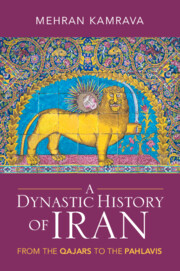Book contents
- A Dynastic History of Iran
- A Dynastic History of Iran
- Copyright page
- Contents
- Figures
- Tables
- Preface
- Acknowledgments
- 1 Introduction
- 2 Qajar Autocracy
- 3 The Constitutional Revolution
- 4 The New Dynasty
- 5 Iran and Great Game Politics
- 6 Dynasty Consolidated
- 7 Economic Development, Political Underdevelopment
- 8 The Gendarme of the Region
- 9 The Monarchy’s End
- 10 Conclusion
- Bibliography
- Index
3 - The Constitutional Revolution
Published online by Cambridge University Press: 18 August 2022
- A Dynastic History of Iran
- A Dynastic History of Iran
- Copyright page
- Contents
- Figures
- Tables
- Preface
- Acknowledgments
- 1 Introduction
- 2 Qajar Autocracy
- 3 The Constitutional Revolution
- 4 The New Dynasty
- 5 Iran and Great Game Politics
- 6 Dynasty Consolidated
- 7 Economic Development, Political Underdevelopment
- 8 The Gendarme of the Region
- 9 The Monarchy’s End
- 10 Conclusion
- Bibliography
- Index
Summary
Approximately halfway through the life of the dynasty, by the mid-1800s, the Qajars’ traditional, largely tribal, sources of legitimacy no longer sufficed to keep emerging social forces politically compliant. This resulted in the increasing political significance of a number of groups, each of which had their own constituents. When groups with corporate identities, such as clerics and merchants, mobilized within and amongst themselves, they could command considerable respect and following among the population at large. Some of the more notable of these groups included the clergy, merchants, landlords, tribal leaders, the small but growing number of reformist intellectuals, and princes, who entered into coalitions together and, with overt and subtle support from the British, sought to change the dynasty from within. The collective power of these groups to place demands on the court was considerable, ultimately resulting in a movement that resulted in the convening of a parliament and the drafting of a constitution. The movement came to be known as the Constitutional Revolution.
Keywords
- Type
- Chapter
- Information
- A Dynastic History of IranFrom the Qajars to the Pahlavis, pp. 35 - 59Publisher: Cambridge University PressPrint publication year: 2022



